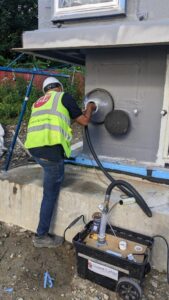
When it comes to a building’s QA/QC plan, the smaller “details” are very important, especially when related to air infiltration at often-overlooked fastener, nail, and screw penetrations in building envelopes and air barrier systems. Bubble Gun Test to the rescue: simple and efficient, the Bubble Gun Test detects air infiltration at individual penetrations of the air barrier membrane and, when testing self-adhered air barrier membranes, it can also detect air infiltration at seams.
 What are the benefits of the Bubble Gun Test?
What are the benefits of the Bubble Gun Test?
-
-
- Compliance: Meets ASTM E 1186 Testing Standard, section 4.2.7.
- Versatile: Can be conducted on small areas of potential concern at multiple locations and on old or new buildings and on field mock-ups.
- Nondestructive: causes no damage to air or waterproofing systems.
- Field-friendly: can be performed during construction or maintenance, providing immediate feedback on air infiltration conditions.
- Cost Effective: relatively inexpensive compared to other testing methods, it also can improve energy efficiency in climate-controlled buildings (heating, cooling, and dehumidifying) and improve occupant comfort.
-
Briefly, How the Bubble Gun Test works:
A liquid is applied to the surface to be tested, then a chamber is placed over the testing area, creating an area of depressurization. If air infiltration occurs, bubbles are created inside the test chamber. Areas of air infiltration are identified and can then be repaired.
Knowing where air infiltration occurs is key to taking steps to improving and maintaining a building’s healthy indoor air quality and keeping down indoor climate control expenses. For further information or to schedule a Bubble Gun Test, contact Mr. Reza Foyouzi, Director of Building Enclosure Services, rfoyouzi@thompsonlichtner.com
